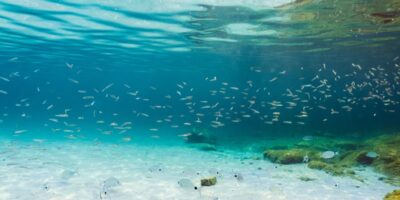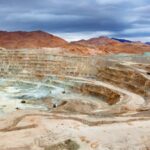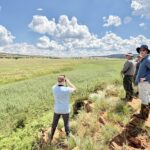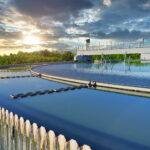This year marks the 30th anniversary of the first offshore wind farm installation! Today, the offshore wind industry is accelerating rapidly and considered one of the world’s fastest growing energy sources. But how has the offshore wind industry changed over the past 30 years and where is it heading?
To find out, we asked Frank Thomsen and Henrik Kofoed-Hansen from the offshore wind team at DHI, to share their insights. Check out some of the highlights in the interview below.
In 1991, Elkraft—later DONG Energy, now Ørsted, launched the first offshore wind farm off the coast of Denmark. What were you doing then and what was your reaction to the first offshore wind farm?
Henrik: 30 years ago, wow! I got my master’s degree from DTU [Technical University of Denmark] that year and immediately after, I was employed at DHI. It was an exciting time for a young and ambitious engineer. We did some cutting-edge research and field experiments at the Vindeby site where the new offshore wind farm was established. That was really the start of my career within the offshore wind business.
Frank: For me, I graduated in 1999 and the topic for my thesis was about acoustic behaviour—the noise behaviour—of marine mammals. The chance of landing a job based on this kind of PhD dissertation was next to nothing in northern Germany, where I graduated. Then, one day, I was sitting in the university lab working on my job applications when along came this guy who turned out to be a consultant for an offshore wind farm. He went around asking, ‘Does anyone here know anything about whales and underwater sound?’ In that instant, I knew I had a good chance. And so, I’ve been working on these issues since then.
What have been the biggest milestones in the industry over the past 30 years, specifically related to regulations?
Frank: Well, I don’t think there has been one single milestone. The first offshore wind farms in Denmark and the UK have given us lessons learned, for example, when it comes to environmental impacts—especially on how to monitor the impacts of an offshore wind farm. One milestone, 20 years ago, was the launch of the first standards for environmental impact assessments (EIAs) published in Germany. That really provided security for developers to know how to carry out these assessments. But overall, just knowing for a fact that it was actually possible to successfully install a wind farm was definitely the biggest milestone.
Henrik: I think the single most important milestone for the industry has been its ability to deliver cheaper, clean energy compared to fossil-fuel based energy over the last 10 years. This is a major achievement, and the entire supply chain should be very proud of this. That said, without the visionary, supportive governments and policy makers setting ambitious climate targets that focus on research, development and innovation programs, we would never be where we are today. It really calls for long-term planning at many different levels to get developers and the entire supply chain to be committed.
Of the emerging offshore wind markets, which regions are you most excited to work with and why?
Frank: There are so many opportunities. We have been working a lot in Poland where the regulatory development was not as mature in the beginning. But now, the wind farms are established with a very low environmental footprint due to the very good EIAs undertaken. So, we’re seeing huge benefits when we’re pioneers in a new market. That’s really a big reward and it continues to excite me to support this development. And then of course, the US is the new frontier of offshore wind because it is a very large market with a lot of development and interesting environmental challenges to consider.
Henrik: It’s always exciting to work with emerging countries because of the different cultures, different standardisations, different ways of doing things—and we get to learn from each other. In general, I do not have specific preferences, but the emerging Asia-Pacific market is exciting and challenging on many fronts. I’m looking forward to it and am already heavily engaged in and learning about it every day.
What do you think are the major technical influences, changes or innovations that have helped the industry advance over the past 30 years?
Henrik: That’s a very good question! It’s quite a complex industry so there are many, but I think innovation across the entire supply chain and its industrialisation is crucial. The growth in size of wind turbines has had a significant influence on the power price. Today, we work with 8-12 MW turbines but in a few years, we will be working with 14-15 MW turbines, which have about 40 times higher capacity compared to where we started 30 years ago. And just imagine, each of these single turbines or power plants as is, will deliver power to 10,000 homes!
Do you think the United Nations’ Sustainable Development Goals (SDGs) are influencing offshore wind development?
Frank: Two SDGs are directly applicable to offshore wind; Goal 7: Ensure access to affordable, reliable, sustainable and modern energy for all, and Goal 14: Conserve and sustainably use the oceans, seas and marine resources for sustainable development.
I’m not sure if there is a direct impact from these goals, but I think they indirectly foster research. Today, there are project funds available in Europe for work done in, for example, underwater noise impacts on marine life. And we have also seen companies reacting to these global trends—we see a shift in some of the major oil and gas players investing heavily in offshore wind. If you look at the US right now, with the new administration, there’s a lot of support for offshore wind—and this will result in major influences on the industry as a whole.
Europe has played a major role in early offshore wind development. How are other regions learning from these European examples and what have been their biggest challenges on their offshore energy journey?
Henrik: Europe has been a very successful pioneer in the offshore wind industry, and this has been an invaluable inspiration and learning model for many emerging countries. Now we see it’s really taking off in Asia-Pacific and North America. It’s difficult for me to point out the single biggest challenge, as it varies from country to country, but many European authorities, developers and private companies are supporting these emerging markets get started quickly.
Frank: There are two main challenges when it comes to environmental issues. One is providing the regulatory landscape, i.e., managing or implementing a decision process where wind farm projects can be consented swiftly while protecting the environment. That’s a challenge especially for the upcoming markets because they simply lack the experience. This is where information transfer comes in—site visits, workshops, meetings, and conferences are really important in this context.
The second challenge is managing specific environmental issues as they vary in different areas. In the US, for example, there are large whales that are very sensitive to low frequency sound from pile driving. In Taiwan, the humpback dolphin is highly protected and needs special attention. We can, of course, learn from European examples, but we can only learn so much because some of the issues are context specific.
Pivoting the conversation to your expertise, Henrik, what are the major changes in offshore metocean engineering services in the past 30 years? And Frank, how have environmental impact assessments and technologies evolved since?
Henrik: It’s no secret that fit-for-purpose and quality metocean data and analytics have been one of my key interests for decades. Why? Because solid and reliable data is crucial for any successful offshore wind or other projects at sea throughout each development phase. It really matters. Today, the combination of solid and proven numerical models, both for the atmosphere and the ocean, as well as access to huge computational power resources, allow us to calculate metocean conditions accurately, anywhere, in a fraction of time compared to just 10 years ago. It also allows us to undertake much more advanced analysis and disseminate these results digitally, quicker and cheaper. Its impressive to see how this started 30 years ago and to see where we are today.
Frank: For sure, we have seen a huge progress in environmental monitoring. Twenty years ago, I was on an airplane counting harbour porpoises in the North Sea using just my eyes looking out from a bubble window. Nowadays, we have high-definition video aerial surveys and great progress in all kinds of other monitoring tech and processes. Acoustic monitoring, the monitoring of underwater noise, can now be done online. We have developed multi-sensor bird detection systems where you can detect birds flying through a wind farm and assess the risk of collision 24/7.
From an ecological point of view, we are interested in finding out not only what is there and when they are there, but also why they are in an area, what actually drives their movements. Today, all this can be done using spatial ecological modelling, dynamic habitat modelling and agent-based modelling.
Interested in more offshore wind insights?
Check out another of our interviews here: Why is dynamic modelling of marine species an advantage for the offshore wind industry?
For 30 years, DHI has developed standards and tools to optimise wind farm design and ensure safe construction, operation and maintenance. Recognised as best-in-class by certifiers, our methods, data and ecological modelling tools help identify potential impacts early to ease approval processes and reduce risks.








